Making Space for Learning Part Deux: It’s Not All Just Hokki Stools and Standing Desks
This blog post was co-written by neighbours and teacher-buddies Matt Fabbri and Annick Rauch when, after one night, out of the blue, Matt texted Annick and said, “Let’s write a blog about the importance of varied learning spaces in high school as well as early years”. He knows the way to her heart. Read Part 1 of this blog by clicking here to learn about Matt and Annick’s journeys and why offering a variety of learning spaces in the classroom is crucial. Enjoy Part 2:
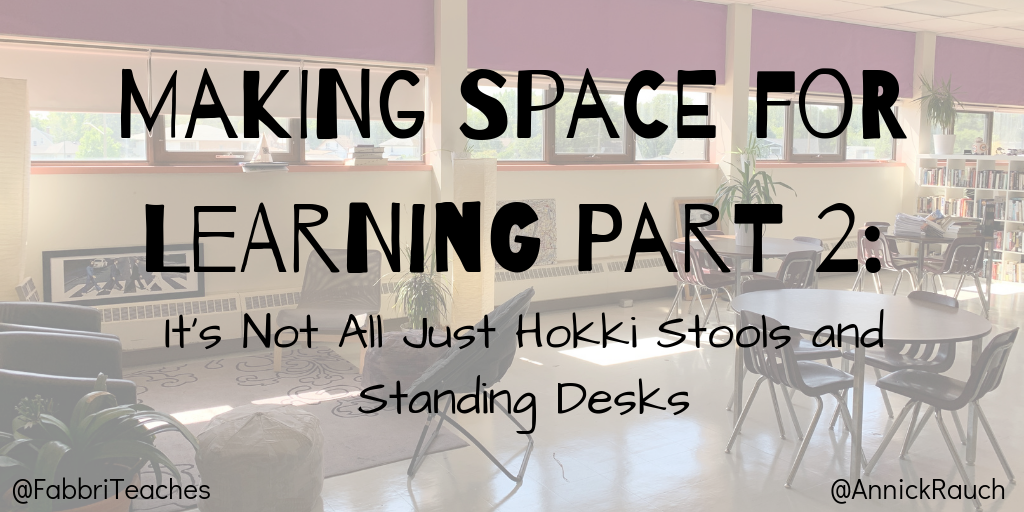
AR: How’d your classroom set up go?
MF: It’s still in progress. We had our floors waxed so it offers up this great opportunity to decide what we want to do – especially since I’m in a brand new-to-me space – but that meant that I just paced the room in circles for about 2 hours trying to imagine things first in my mind. You?
AR: I’m done.
MF: Of course you are. I got the basic “rooms” or spaces within my room mapped out but there’s a lot of “housekeeping” and prettying up to do.
AR: What spaces do you have?
MF: Minimal. I need the overall space to “become” as many things as I need it to be. So I’ve got a little conversation nook with comfy seating, and then I’ve got 4ft round tables for those who need desk space and for more collaboration. And then I’ve got a space behind my classroom library that’s reserved more as a low-stim space for students needing to just face a wall, put headphone in and get to work. So that’s all done.
AR: The big stuff.
MF: Yeah. You?
AR: Yeah, same. I’ve got different table heights, hokki stools and zuma rockers for kids who need to move, high tables with swivel chairs for those who need to stand and sit, the carpet area for students who like to lay down and work while meeting their deep pressure sensory needs, and the comfy pillow area or couch for quieter spaces.

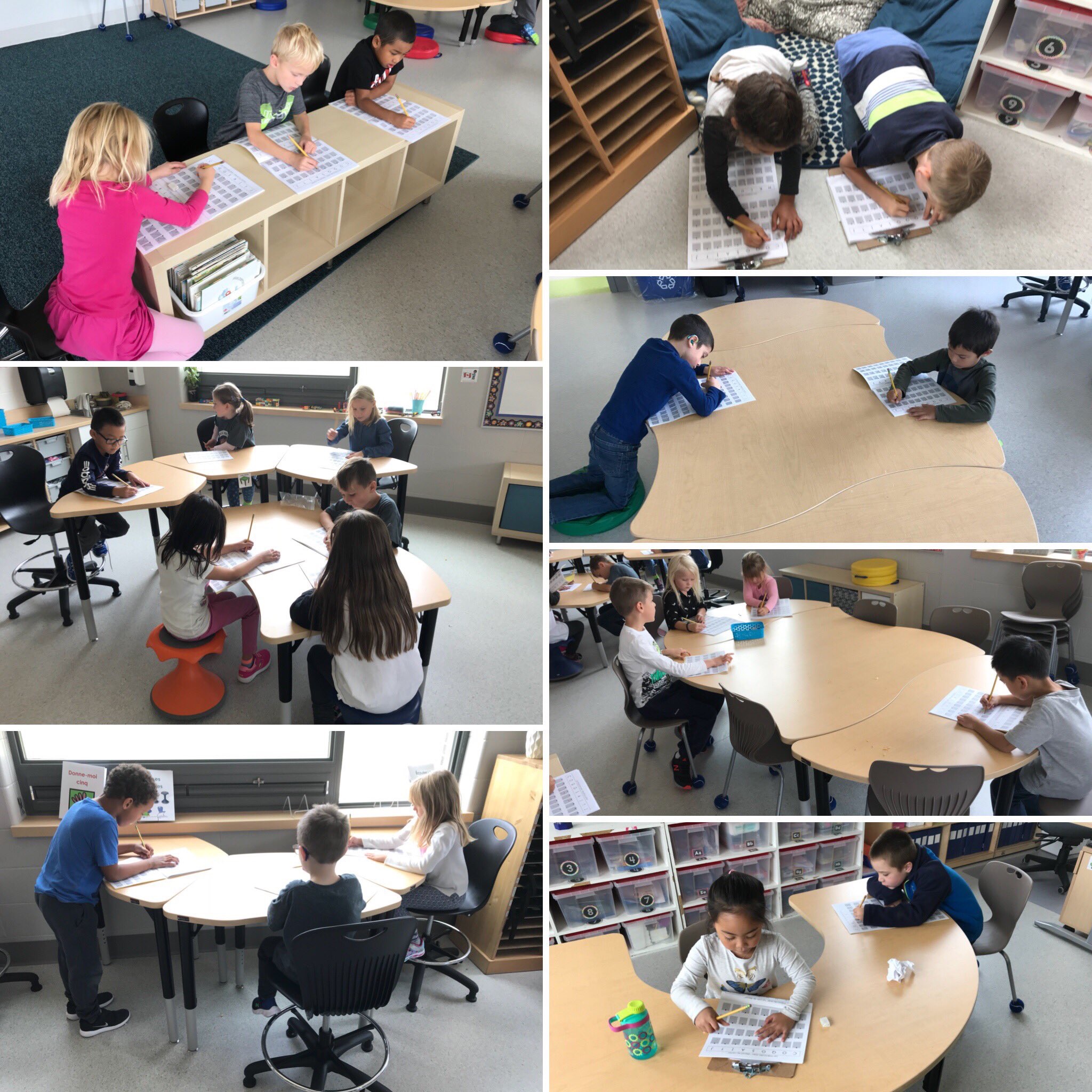
MF: The aesthetic design of the space is that ‘sexy’-Pinterest-worthy thing that everyone jumps on, thinking that that is what makes a good classroom, but that’s all really just surface level. You have to identify what the real issue is, before you adopt an aesthetic for the space.
As you read in our first post, we have both been on different journeys, but it was our constant push for doing what’s best for our students by finding out how they learn best, and reflection and iterations, that got us to where we are today.
So, you have your space – now what?
You’ve put in the blood, sweat, and tears into having a variety of options for your students to learn, collaborate, create, and have fun in, but your job isn’t over. In fact, it’s just beginning. Just because you’ve created the space, doesn’t mean it will be used properly and effectively. So, now what? We’re not saying that our way is the only way, but here are tips and tricks we’ve discovered along the way:
MF: First – I hate when Pinterest just shows you a finished classroom and goes “BAM! Do this!” and you’re like, “Great. So now what…” So I think first things first is that we have to remember that in our own working spaces (See last week’s post!), we both work well because we’ve found a physical spot that works for us. BUT there is a variety of choice in the picking. And, I think, that’s key here: a choice. So we can talk about flex seating all we want, but regardless of what furniture you have, the students need to be equipped to make choices that work for them and their productivity.
It’s really easy for me to talk about choice, when my kiddos are who they are (high schoolers), but what does choice look like in the early years when they don’t necessarily know how to make choices yet?
AR: So, I’m all for voice and choice – but an extreme level of that is WAAAAY too much to handle for most students when they’re not even used to a full day of school yet. Heck – when I get home after school – my husband knows that I don’t make decisions anymore! All this to say that my flex seating routine goes a little something like this:
During opening day conferences (where I am SUPER fortunate to have: 15 minute meetings with each of my students and their families, individually), while beginning to build relationships and easing the “First Day” stress and anxiety, my students find their name on a cute little printout, and place it at one of the seats anywhere in the classroom. Some students walk around the class, try out different chairs, and ask me questions. Other students try to find the name of someone they know to sit near them. But before they leave, every student ends up picking a spot – a spot that is theirs, a spot in which they can find comport knowing that THIS is where they can head on the first day of school if they’re feeling unsure, nervous. This is their home-base.
Getting settled into grade one takes time, a lot of time, and until I have time to properly explain and explore flexible seating with my students, we don’t have rules. If something comes up before we’ve had a chance to talk about it, it becomes a teachable moment. But eventually, the goal is for my students to be self–aware of where they work best in the varied learning spaces. Self-regulation becomes a big part of this, which is a huge component for anyone… but just imagine how much easier it would be for high school teachers *cough! … Matt … cough!* if this was taught in the early years and every teacher continued to build on these skills each and every year. Talk about powerful.
MF: *cough … I know … cough cough … thanks for that! … cough cough phlegm cough…* We can talk about hokki stools and rockers, or high tables, low tables all we want. But without self-regulation, none of those things matter. I’m less concerned with the actual tool and more concerned with the purposes of spaces for the sake of the student.
For instance – in my previous room-space, I had a built-in large closet – a chemical supply room, it was previously a dedicated science lab that was turned into a cross-discipline space. So we didn’t need a chemical room anymore, but the space was still there. I found much success turning that into a low-stimulus space for students – I had some fairy lights draped along the ceiling and walls, some IKEA lamps in there – a rug, a club chair. It was great. And students USED it – they had to be taught what it was for – but once that was done, it was used by those who needed a quiet space.
Actually, one student who was extremely unproductive because of his peers used the room DAILY when it came time to buckle down and work. He was productive in that space, and unproductive without it.
When I moved classrooms, I knew I *needed* another low stim space. But this time, I had to create one.
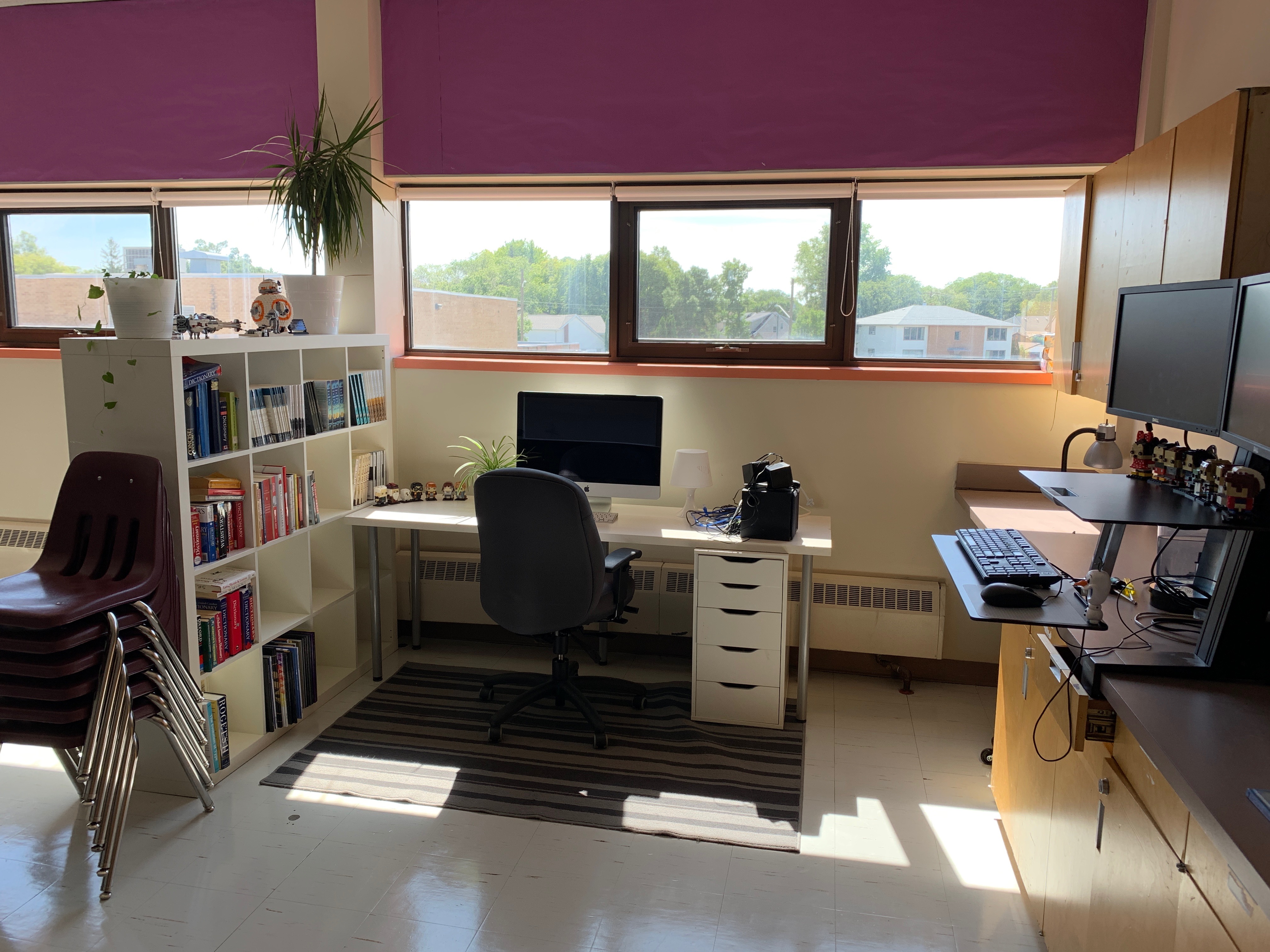
AR: I use my comfy cushion area that’s all pillows or my couch for the same purpose.
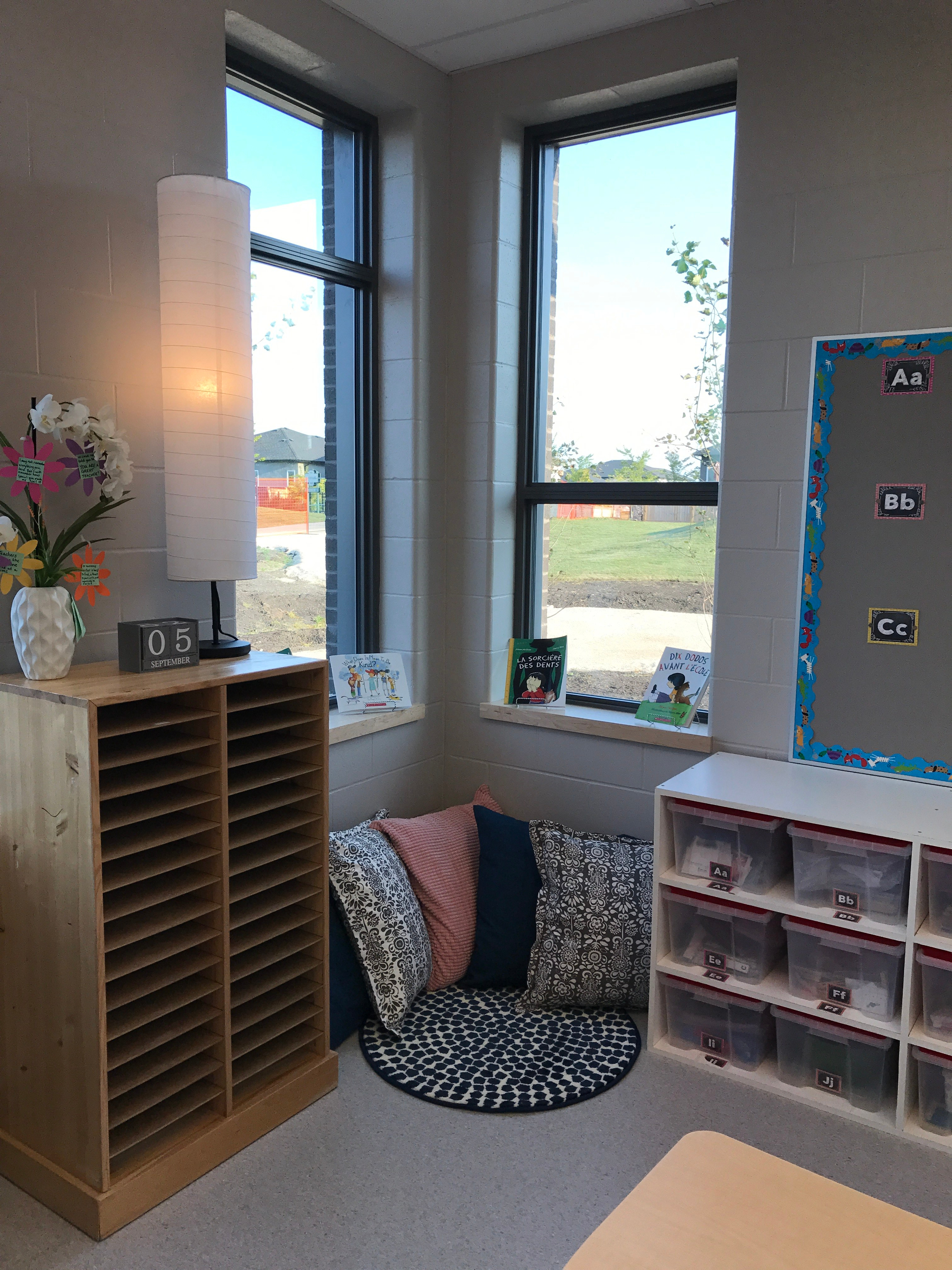
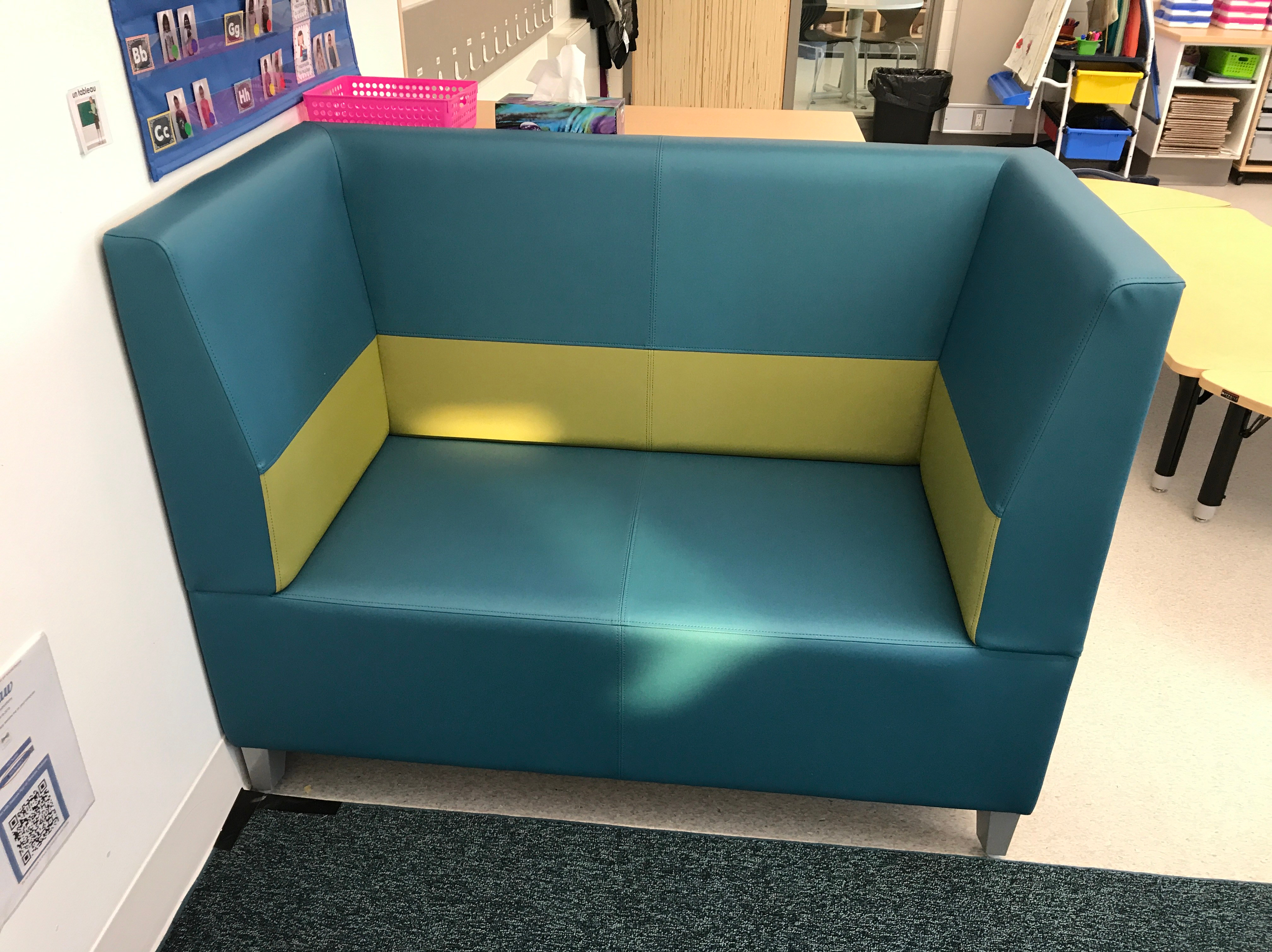
MF: And I know that Kate’s 3rd grade classroom (my eldest daughter who in enrolled at Annick’s school in 4th grade English program) had a teepee, and that was their low-stim space or reading area. The tool doesn’t matter. What matters is that the space exists for the students to use it properly.
AR: Right! So, to teach them how to use these spaces EARLY, I start off with a little “book” or social story that I created (sorry it’s in French 😊). This gives us the chance to talk about my expectations, how they should be using the different options, and the importance of doing our part so that our class can function well.
MF: Yeah. I’m not that fancy.
AR: But you don’t need to be.
MF: Hashtag-high school.
AR: The book is very simple, allowing us to read it several times, and often, when we need reminders.
MF: Also hashtag-high school.
AR: Since my students lead often in the classroom, we even get to a point where students will grab the book and read it to the group when they notice reminders are needed.
MF: You should do a blog-post on social stories later.
AR: Yes… one day!
MF: OR do an Instagram story on social stories! Then it’s a SOCIAL STORY on SOCIAL STORIES!
AR: … eye. roll.
MF: Hashtag-dad joke!
AR: Anyways… Over the next week of school, the students take turns trying out all the different seats and picking their spot for the next day. During this time to explore, we have several discussions about what works and doesn’t work so that they can begin seeing things on their own. Then once everyone’s rotated through, they choose their “home-base” for that month. They can still switch and move around as much as they want, asking others to use a space if it’s occupied, yadda yadda… but their home-base is their home-base. That’s important for students who have a hard time choosing, or are overwhelmed by the task itself in front of them. This way, they have somewhere to go that’s theirs if they want it.
MF: In my space, at the start of school, I’ll explain the room. But I’ve got three zones – the general work space, the quiet area, and the “Nook” – so it’s simple. But my students sit anywhere they want. It doesn’t matter to me. Some teachers would be driven up the wall by that, and others just like a little more control. But I’ve learned that unless there’s a real problem with productivity, students will learn what they’re best “spot” is in my room and regulate to that. Some students – even if they’re coming from a history of classrooms like yours where the learning about their spots is more overt – need a conversation or two (which is, as we know, all part of teaching) to help them realize —
Actually, this was LITERALLY just on an episode of the show Suits. (I’m a season behind … no spoilers please…) A character was being assessed on his productivity and was going to be fired when Donna (LOVE Donna!) helps the Fire-er (English degrees get to make up words!) realize that he’s only not delivering on productivity because he is literally surrounded by others who are not productive! Helping students see this for themselves in respectful ways – like my one kiddo who needed that low-stim space to be productive – is part of this.
AR: So in your class, they migrate, too.
MF: They can, and do. Actually our whole classroom is a fluid space.
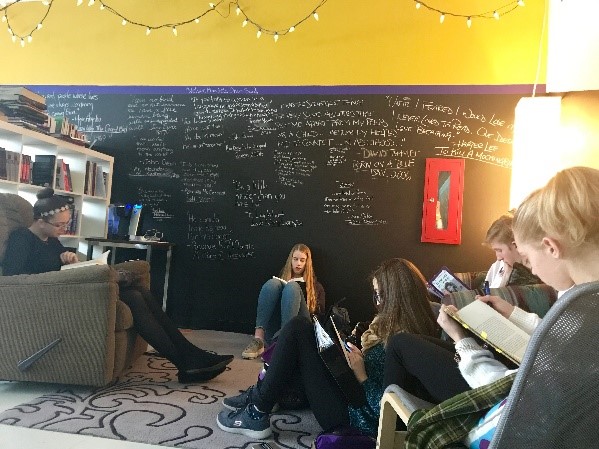
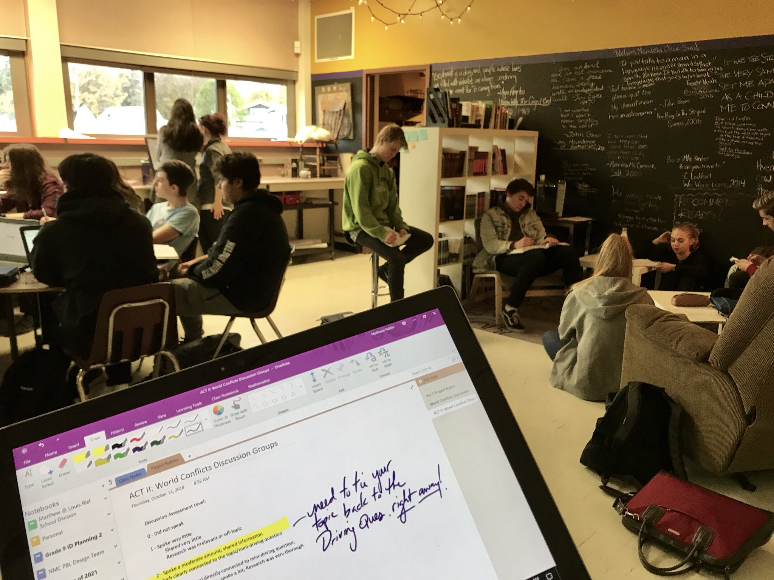
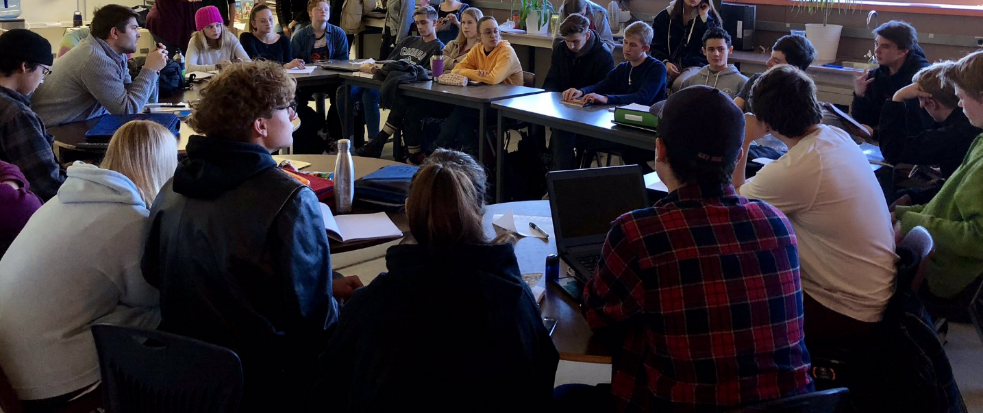
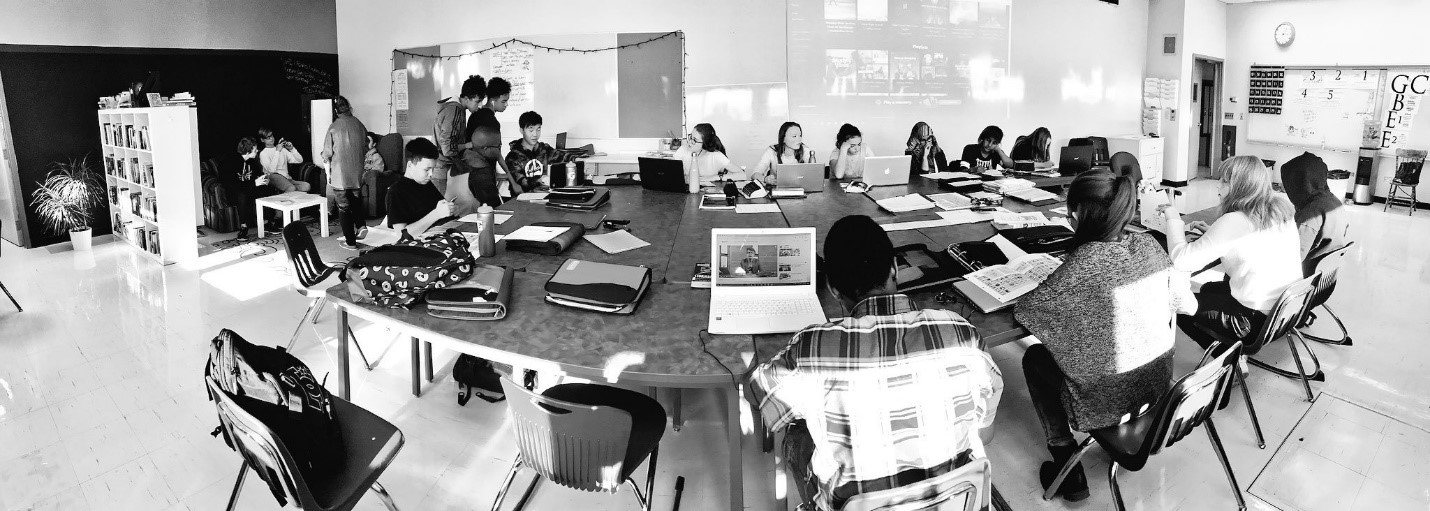


If there’s a problem with productivity, I intervene. But, it’s weird: they really do develop spots over time, and it’s very unspoken. It’s kind of cool. I have been known to “shut down” or “close” an area of my classroom from time to time just so I can have their undivided attention for 10 minutes —
AR: The couches?
MF: Yeah, it’s the “fun” space. Don’t know why.
AR: Same reason there’s never any club loungers at Starbucks when you want one.
MF: Right?! But then after I open it, it’s a mad rush for that space. Like at Starbucks…
AR: Are you mean and restrict who goes there, like I do?
MF: I’ve been known to ban students, yes. But mostly in 9th grade. Especially if they’re abusing that time. In 11th and 12th grades, no. If you’re going to go there and do nothing, then that’s an active choice you’re making. And I’ll let you know you’re making that choice, and I’ll, what I call, “play out the movie” for them to explain what will come if they continue it, but no – they must make that for themselves at that age. If they fall, they fall. And I’ll be there. But that’s so rare, it almost isn’t even worth bringing up.
That said, I did have a student this past year who was struggling on multiple levels – all having to do with her life outside of my classroom. And, at the time, I was in a different room and had this big, old, musty recliner – kind of like Joey and Chandler’s barcaloungers from Friends, but much grosser … anyway. She would come – when she would come to class – and she’d sit there and read or journal, but always off topic. Never doing what everyone else was doing. But then she’d leave my room and produce beautiful writing – painful, reflective stuff! – that was on-task and turned in her work. Did I care? At first, but then I thought: she’s turning the work in. It’s on time. She’s just doing what I do – she’s in her spot. She’s comfortable, she’s self-regulating after a night of God-knows-what at home. Sometimes that needs to happen in a high school classroom.
AR: So let’s do a separate post on THAT! That’s a whole BOOK!
MF: Next summer … granted, I was running a writer’s workshop in Grade 12 ELA at that time and I had that flexibility to let her be. Not all teachers choose (or have the choice to choose) to run their class that way. (But I HIGHLY recommend it and, if you venture in that direction, check out Penny Kittle and Kelly Gallagher’s separate and joint work in that area.)
Oh! The one person that doesn’t have a spot is me.
AR: You don’t have a desk?
MF: No. For me, the desk was a barrier between me and the students. And I wanted to take that barrier down. That’s just me and where I was at in my mind. It slowly moved from a traditional desk I sat behind, to a desk I sat next to, to a desk that was slid up against the wall, to a section of counter in my classroom last year, to being completely gone now.
Now, I’ll have a few different hang-outs in the room. I’ll conduct a lot of my conferences in the couch area (repurposed club chairs from a library refurb and IKEA and Target clearance items), or I’ll commandeer a table that’s not being used. But for the most part, my Microsoft Surface 4 allows me to have everything – even projector capabilities – in my hands at all times. So I don’t need a spot. I gave up my teacher desk a long time ago. And now I use OneNote for all things – student assessment included. Actually this year I’m giving up more – my whiteboard space now belongs to student goal-setting and productivity logging, and using Microsoft OneNote on the SurfacePro to project all of our mini-lessons. (But that’s another blog post.)
AR: I can’t function without a desk.
MF: And my teaching partner can’t either. She needs her own space. And that’s fine for her. She’ll still conference out in her class, at the students’ spots with them – she’s super awesome at that. She’s super awesome in a lot of areas. I just make them come to me wherever I am —
AR: Is that a conscious choice? Or laziness.
MF: On Mondays it’s laziness … and on Fridays it’s probably exhaustion, but during the rest of the week it’s a conscious choice to get them out of their spot and into a “meeting” where they may have to justify their choices. Most days it’s just any opportunity to get them to stand up and move.
AR: And then sit down in a different spot.
MF: Sure. But things are a lot easier if they have some prior schema of self-regulation and “spot finding”.
AR: But the important thing – in your space and mine – is that the students ALWAYS have a home-base.
MF: And they have voice and choice in what home-base is. In your class it’s overt; in mine, not.
AR: And, like you said, developing that schema and that skill takes time. But if we do our jobs in these twelve years, and teach them about self-regulation, and productivity, and where and how they are most productive, they’ll be better equipped for life.
MF: The goal here isn’t so that they take exams and tests better. Nor is it about their percentage or GPA. In the end, that all matter very little beyond academia. What matters is for them to develop the same understanding that you have as an adult with your best “home-bases” to work in, and I with mine.
AR: YES! Because if we work with them on these foundational principles, everything else will become easier to develop.
*high five*
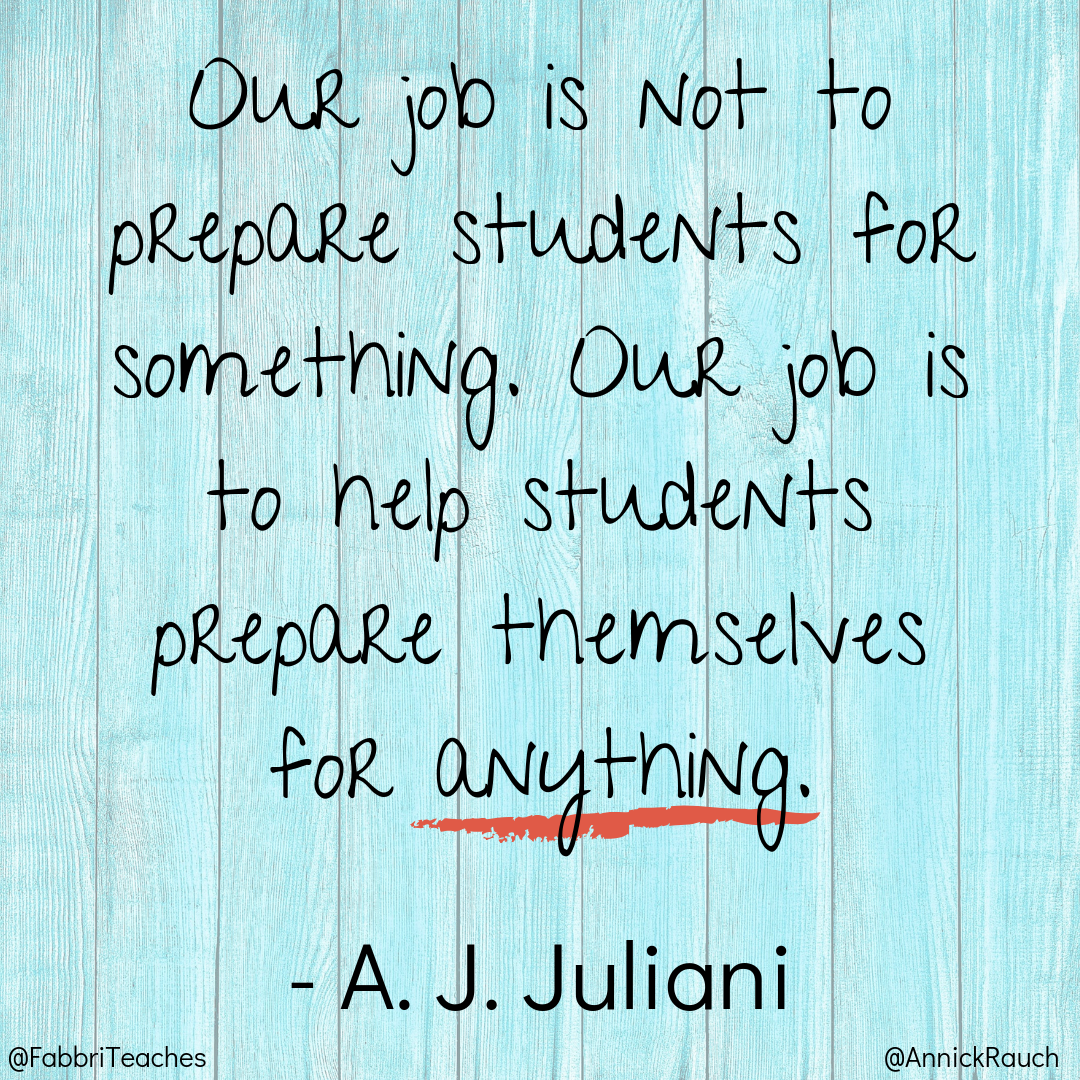
Ready to take it a step further? Why not have your students set up the space on the first day of school! We love how Sara Ballard did this with her 5th grade students. Read more about it in Katie Martin’s post 4 Ways to Create a Learner-Centered Classroom.

Leave a Reply